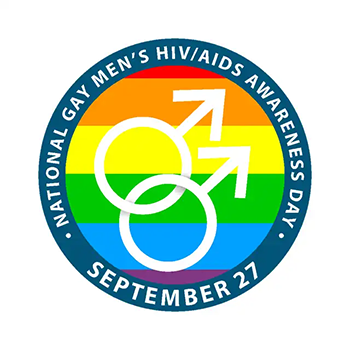National Gay Men’s HIV/AIDS Awareness Day
National Gay Men’s HIV/AIDS Awareness Day (NGMHAAD) was first recognized in 2008 by the National Association of People with AIDS to raise awareness of the disproportionate impact of the HIV epidemic on gay and bisexual men in the United States. The observance offers an opportunity to fight stigma and encourage HIV testing, prevention, and treatment among gay and bisexual men. This population faces multiple challenges – such as racism, discrimination, homophobia, and stigma – that may increase the risk for HIV.
Gay and bisexual men accounted for 67 percent of new HIV diagnoses in the United States and dependent areas in 2021, according to the Centers for Disease Control and Prevention (CDC). Within this population, certain racial and ethnic groups and age groups are disproportionately affected. Disparities persist among Black and African American and Hispanic or Latino gay and bisexual men, who receive more new HIV diagnoses than those of other racial and ethnic groups. In addition, young men aged 13–24 with HIV are more likely to be unaware of their HIV status than men of different age groups.
The National Institutes of Health (NIH) HIV research program supports research to better understand and reduce HIV-related health disparities based on sexual orientation – as well as other factors such as race and ethnicity, socioeconomic status, and age – to improve HIV testing and engagement and retention in prevention and care services.
Check out these HIVinfo resources to learn more:
- HIV and Gay and Bisexual Men (Fact sheet)
- Lesbian, Gay, Bisexual, and Transgender (LGBTQ+) (HIV Source)
- The Basics of HIV Prevention (Fact sheet)
- Pre-Exposure Prophylaxis (PrEP) (Fact sheet)
- PrEP vs. PEP (Infographic)
Social Media
Use the hashtag #NGMHAAD to follow the conversation about this awareness day on social media. Check out the “Use Digital Communication” resources on the HIV.gov National Gay Men’s HIV/AIDS Awareness Day webpage for tips on how to amplify the conversation, spread awareness on social media, or download social media graphics.

Additional Resources
National Institutes of Health (NIH) Office of AIDS Research (OAR)
- FY 2021–2025 NIH Strategic Plan for HIV and HIV-Related Research (NIH HIV Strategic Plan). Developed by OAR, the NIH HIV Strategic Plan describes NIH research priorities to prevent, treat, and eventually cure HIV and AIDS. The NIH HIV Strategic Plan includes efforts to develop HIV prevention and treatment strategies that are tailored for different populations, such as gay and bisexual men, as well as to mitigate HIV-associated stigma and discrimination among diverse populations.
- This OAR webpage describes how NIH-funded research is helping to reduce the incidence of HIV through clinical trials to test effectiveness of potential HIV vaccines, as well as through research to advance other nonvaccine prevention methods.
- This OAR webpage describes HIV prevention strategies, including several tailored for gay and bisexual men.
NIH Sexual & Gender Minority Research Office
The NIH Sexual & Gender Minority Research Office (SGMRO) coordinates sexual and gender minority (SGM)-related research and activities across NIH Institutes, Centers, and Offices. Read SGMRO’s strategic plan to learn more about its support of SGM and HIV/AIDS research.
Clinical Trials Among HIV and Gay Men
Find clinical trials related to HIV prevention, treatment, and care among gay men at ClinicalTrials.gov. For example, the HIV Prevention Trials Network is conducting a study to develop strategies to increase HIV testing and services that potentially can reduce HIV among Black men who have sex with men (MSM) in the southern United States.
Read the HIVinfo HIV and AIDS Clinical Trials fact sheet to learn more about clinical trials. Call HIVinfo at 1-800-448-0440 for assistance with your clinical trials search.
Additional Resources from CDC
CDC has several webpages that provide information on HIV prevention, incidence, diagnoses, and more tailored for gay and bisexual men who have sexual contact with men (MSCM).
- This webpage provides HIV-related information for all gay and bisexual men and MSCM. Tailored information also is available on HIV for African American gay and bisexual men and MSCM, as well as for Hispanic/Latino gay and bisexual men and MSCM.
- The HIV and Men webpage includes HIV-related for men and those who were assigned male at birth.
- The Gay and Bisexual Men's Health webpage provides an overview of the different health issues, including HIV, faced by gay and bisexual men.